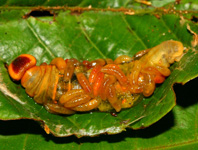Abstract
Geometric morphometrics (GM) is a powerful analytical approach for evaluating phenotypic variation relevant to taxonomy and systematics, and as with any statistical methodology, requires adherence to fundamental assumptions for inferences to be strictly valid. An important consideration for GM is how landmark configurations, which represent sets of anatomical loci for evaluating shape variation through Cartesian coordinates, relate to underlying homology (Zelditch et al. 1995; Polly 2008). Perhaps more so than with traditional morphometrics, anatomical homology is a crucial assumption for GM because of the mathematical and biological interpretations associated with shape change depicted by deformation grids, such as the thin plate spline (Klingenberg 2008; Zelditch et al. 2012). GM approaches are often used to analyze shapes or outlines of structures, which are not necessarily related to common ancestry, and in this respect GM approaches that use linear semi-landmarks and related methods are particularly amenable to evaluating primary homology, or raw similarity between structures (De Pinna 1991; Palci & Lee 2019). This relaxed interpretation of homology that focuses more on recognizable and repeatable landmarks is defensible so long as authors are clear regarding the purpose of the analyses and in defining their landmark configurations (Palci & Lee 2019). Secondary homology, or similarity due to common ancestry, can also be represented with GM methods and is often assumed to be reflected in fixed Type 1 (juxtaposition of tissues) or Type 2 (self-evident geometry) landmarks (Bookstein 1991).
References
Bookstein, F.L. (1991) Morphometric Tools for Landmark Data: Geometry and Biology. Cambridge University Press, Cambridge, 435 pp.
https://doi.org/10.1017/CBO9780511573064
Chang, C., Wu, P., Baker, R.E., Maini, P.K., Alibardi, L. & Chuong, C. (2009) Reptile scale paradigm: Evo-devo, pattern formation and regeneration. International Journal of Developmental Biology, 53 (5–6), 813–826.
https://doi.org/10.1387/ijdb.072556cc
Davis, M.A., Douglas, M.R., Collyer, M.L. & Douglas, M.E. (2016) Deconstructing a species-complex: geometric morphometric and molecular analyses define species in the western rattlesnake (Crotalus viridis). PLoS ONE, 11 (1), e0146166.
https://doi.org/10.1371/journal.pone.0146166
De Pinna, M.C. (1991) Concepts and tests of homology in the cladistic paradigm. Cladistics, 7 (1991), 367–394.
https://doi.org/10.1111/j.1096-0031.1991.tb00045.x
Di-Poi, N. & Milinkovitch, M.C. (2016) The anatomical placode in reptile scale morphogenesis indicates shared ancestry among skin appendanges in amniotes. Science Advances, 2016 (2), e1600708.
https://doi.org/10.1126/sciadv.1600708
Edwards, S., Herrel, A., Vanhooydonck, B., Measey, G.J. & Tolley, K.A. (2016) Diving in head first: trade-offs between phenotypic traits and sand-diving predator escape strategy in Meroles desert lizards. Biological Journal of the Linnean Society, 2016 (119), 919–931.
https://doi.org/10.1111/bij.12856
Kaliontzopoulou, A. (2011) Geometric morphometrics in herpetology: modern tools for enhancing the study of morphological variation in amphibians and reptiles. Basic and Applied Herpetology, 25, 5–32.
https://doi.org/10.11160/bah.11016
Klingenberg, C.P. (2008) Novelty and “homology-free” morphometrics: what’s in a name? Evolutionary Biology, 2008 (35), 186–190.
https://doi.org/10.1007/s11692-008-9029-4
Maderson, P.F.A. & Alibardi, L. (2000) The developement of the sauropsid integument: a contribution to the problem of the origin and evolution of feathers. American Zoologist, 40 (2000), 513–529.
https://doi.org/10.1093/icb/40.4.513
Musser, J.M., Wagner, G.P. & Prum, R.O. (2015) Nuclear beta-catenin localization supports homology of feathers, avian scutate scales, and alligator scales in early development. Evolution & Development, 17 (3), 185–194.
https://doi.org/10.1111/ede.12123
Palci, A. & Lee, M.S.Y. (2019) Geometric morphometrics, homology and cladistics: review and recommendations. Cladistics, 35 (2019), 230–242.
https://doi.org/10.1111/cla.12340
Polly, P.D. (2008) Developmental dynamics and G-matrices: can morphometric spaces be used to model phenotypic evolution. Evolutionary Biology, 35 (2008), 83–96.
https://doi.org/10.1007/s11692-008-9020-0
Rafinesque, C.S. (1818) Farther accounts of discoveries in natural history in the western states. American Monthly Magazine of Critical Review, 4, 106–107.
Ruane, S. (2015) Using geometric morphometrics for integrative taxonomy: an examination of head shapes of milksnakes (genus Lampropeltis). Zoological Journal of the Linnean Society, 174 (2), 394–413.
https://doi.org/10.1111/zoj.12245
Sindaco, R., Kornilios, P., Sacchi, R. & Lymberakis, P. (2014) Taxonomic reassessment of Blanus strauchi (Bedriaga, 1884) (Squamata: Amphisbaenia: Blanidae), with the description of a new species from south-east Anatolia (Turkey). Zootaxa, 3795 (3), 311–326.
https://doi.org/10.11646/zootaxa.3795.3.6
Tamagnini, D., Stephenson, J., Brown, R.P. & Meloro, C. (2018) Geometric morphometric analyses of sexual dimorphism and allometry in two sympatric snakes: Natrix Helvetica (Natricidae) and Vipera berus (Viperidae). Zoology, 2008 (129), 25–34.
https://doi.org/10.1016/j.zool.2018.05.008
Tomovic, L., Carretero, M.A., Ajtic, R. & Crnobrnja-Isailovic, J. (2008) Evidence for post-natal instability of head scalation in the meadow viper (Vipera ursinii)—patterns and taxonomic implications. Amphibia-Reptilia, 29 (2008), 61–70.
https://doi.org/10.1163/156853808783431424
Turing, A.M. (1952) The chemical basis of morphogenesis. Philosophical Transactions of the Royal Society B, 1952 (237), 37–72.
https://doi.org/10.1098/rstb.1952.0012
Zelditch, M.L., Fink, W.L. & Swiderski, D.L. (1995) Morphometrics, homology, and phylogenetics: quantified characters as synapomorphies. Systematic Biology, 44 (2), 179–189.
https://doi.org/10.2307/2413705
Zelditch, M.L., Swiderski, D.L., Sheets, H.D. & Fink, W.L. (2012) Geometric Morphometrics for Biologists: A Primer. Elsevier Academic Press, San Diego, 443 pp.


